High Impact Tutoring Built By Math Experts
Personalized standards-aligned one-on-one math tutoring for schools and districts
In order to access this I need to be confident with:
Simplifying expressions Combining like terms Factoring Expanding expressionsAdding and subtracting rational expressions
Here you will learn about adding and subtracting rational functions (algebraic fractions), including rational functions with monomial and binomial denominators. You will also look at how to work with problems that require factoring quadratics.
Students first learn how to work with rational expressions in Algebra I and expand that knowledge as they deeply explore rational functions in Algebra II.
What is adding and subtracting rational expressions?
Adding and subtracting rational expressions is when you add and subtract two or more rational expressions (fractions that contain algebraic expressions). For example, the following are examples of rational expressions:
\cfrac{3}{2x+3}, \, \cfrac{5}{y^{2}} or \cfrac{2ab}{3a+4b}.
Since rational expressions are algebraic fractions, the strategies used to add and subtract them are similar to adding and subtracting fractions. This means that when you have to add and subtract rational expressions, you need to make sure they have a common denominator.
For example, in order to add the rational expressions below, there needs to be a common denominator.
\cfrac{5}{2a^2} + \cfrac{c}{6ab}.A useful strategy to use to find the LCM (least common denominator) of the algebraic denominators 2a^2 and 6ab is using a Venn diagram.
Breaking apart each denominator into its prime factors:
2a^2 = 2\times a \times a 6ab = 6\times 3 \times a \times bNotice how the 2 and a are common to both, this means that 2a is the greatest common factor but NOT the least common multiple (which is the least common denominator).
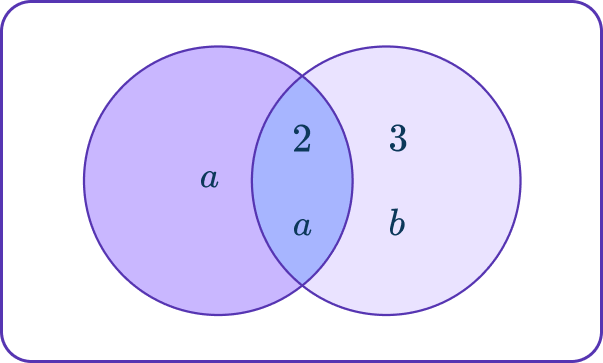
The least common multiple can be found by multiplying each of the factors within each part of the Venn diagram, so
L C M \text { or } L C D=(a) \times(2 \times a) \times(3 \times b)=6 a^2 bNow that we know what the least common denominator is, the rational expression has to be rewritten into an equivalent expression where both denominators are 6 a^2 b.
In order to do that, multiply the numerator and denominator of the first term by 3b \: ( because 3 b \times 2 a^2=6 a^2 b) and multiply the numerator and denominator of the second expression by a \: ( because a \times 6 a b=6 a^2 b)\text{:}
\begin{aligned}& \cfrac{5}{2 a^2} \times \cfrac{3 b}{3 b}+\cfrac{c}{6 a b} \times \cfrac{a}{a} \\\\ & \cfrac{15 b}{6 a^2 b}+\cfrac{c a}{6 a^2 b} \end{aligned}Now that the denominators are the same, you can add the expressions together.
\cfrac{15 b}{6 a^2 b}+\cfrac{c a}{6 a^2 b}=\cfrac{15 b+c a}{6 a^2 b}![[FREE] Algebra Worksheet (Grade 6 to 8)](https://thirdspacelearning.com/wp-content/uploads/2023/07/Algebra-check-for-understanding-quiz-listing-image-.png)
[FREE] Algebra Worksheet (Grade 6 to 8)
![[FREE] Algebra Worksheet (Grade 6 to 8)](https://thirdspacelearning.com/wp-content/uploads/2023/07/Algebra-check-for-understanding-quiz-listing-image-.png)
Use this quiz to check your grade 6 to 8 students’ understanding of algebra. 10+ questions with answers covering a range of 6th and 8th grade algebra topics to identify areas of strength and support!
DOWNLOAD FREE![[FREE] Algebra Worksheet (Grade 6 to 8)](https://thirdspacelearning.com/wp-content/uploads/2023/07/Algebra-check-for-understanding-quiz-listing-image-.png)
[FREE] Algebra Worksheet (Grade 6 to 8)
![[FREE] Algebra Worksheet (Grade 6 to 8)](https://thirdspacelearning.com/wp-content/uploads/2023/07/Algebra-check-for-understanding-quiz-listing-image-.png)
Use this quiz to check your grade 6 to 8 students’ understanding of algebra. 10+ questions with answers covering a range of 6th and 8th grade algebra topics to identify areas of strength and support!
DOWNLOAD FREELet’s look at another example of where you might have to use factoring.
\cfrac{5}{x^2-9}-\cfrac{2}{x+3}Notice how in this case, the denominators are binomials. Look to factor any denominator first before finding the least common multiple.
Using the strategy of factoring the difference of perfect squares, x^2-9 can be factored into (x+3)(x-3)
\cfrac{5}{(x-3)(x+3)}-\cfrac{2}{x+3}Using the Venn diagram strategy, you can see that x+3 is the common factor to both expressions, but you need to find the least common multiple which is the least common denominator.
In order to do that using the Venn diagram, multiply each part of the diagram together. In this case it would be (x-3)(x+3)=\text { LCM or } L C D.
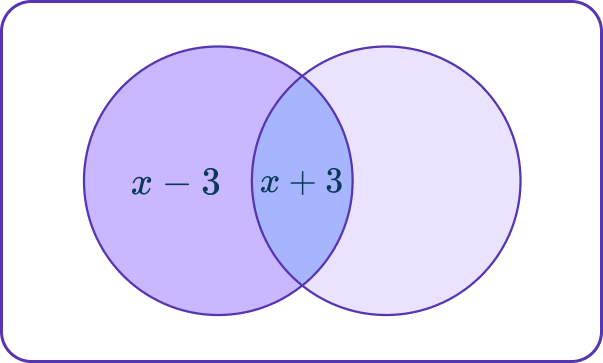
Now, you have to rewrite the expression into an equivalent expression with a common denominator.
The first expression (first fraction) has the common denominator so there is no need to multiply anything to that one. However, the numerator and denominator of the second rational expression has to be multiplied by (x-3) because (x+3)(x-3) is the common denominator.
\begin{aligned}&\begin{aligned}& \cfrac{5}{(x-3)(x+3)}-\cfrac{2}{x+3} \times \cfrac{(x-3)}{x-3} \\\\ & \cfrac{5}{(x-3)(x+3)}-\cfrac{2(x-3)}{(x-3)(x+3)} \\\\ & \cfrac{5-2 x+6}{(x-3)(x+3)} \\\\ & \cfrac{11-2 x}{(x-3)(x+3)} \end{aligned} \\\\ &\cfrac{5}{x^2-9}-\cfrac{2}{x+3}=\cfrac{11-2 x}{(x-3)(x+3)} \end{aligned}You can leave the denominator of the answer in factored form or you can multiply it out.
\cfrac{5}{x^2-9}-\cfrac{2}{x+3}=\cfrac{11-2 x}{(x-3)(x+3)}=\cfrac{11-2 x}{x^2-9}*Note: Always look to simplify the answer if possible.
What is adding and subtracting rational expressions?
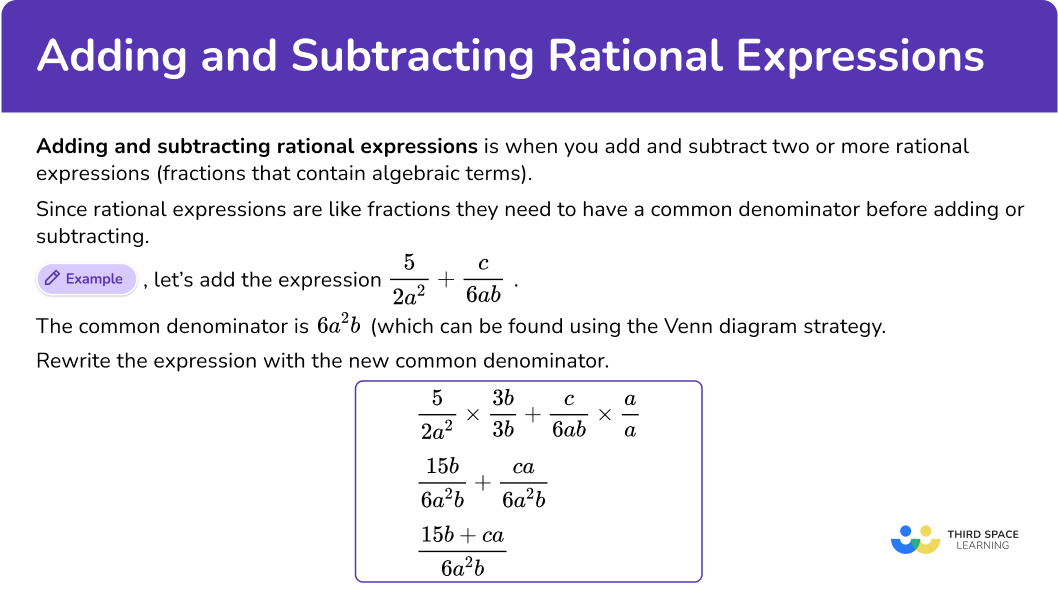
Common Core State Standards
How does this apply to high school math?
- High School Algebra: Arithmetic with Polynomials and Rational Expressions (HSA-APR.D.6)
Rewrite simple rational expressions in different forms; write a(x)/b(x) in the form q(x) + r(x)/b(x), where a(x), \, b(x), \, q(x), and r(x) are polynomials with the degree of r(x) less than the degree of b(x), using inspection, long division, or, for the more complicated examples, a computer algebra system.
- High School Algebra: Arithmetic with Polynomials and Rational Expressions (HSA-APR.D.7)
(+) Understand that rational expressions form a system analogous to the rational numbers, closed under addition, subtraction, multiplication, and division by a nonzero rational expression; add, subtract, multiply, and divide rational expressions.
How to add and subtract rational expressions
In order to add and subtract rational expressions:
- Find the common denominator.
- Rewrite the expressions with the common denominator.
- Add or subtract the expressions.
- If possible, simplify the answer.
Adding and subtracting rational expression examples
Example 1: same monomial denominators
Add the expression and write the answer in simplest form.
\cfrac{5}{m}+\cfrac{8}{m}- Find the common denominator.
The rational expressions have the same denominator.
2Rewrite the expressions with the common denominator.
The rational expressions have the same denominators so you do not need to adjust the expressions.
3Add or subtract the expressions.
Like fractions, add the numerators and keep the denominators the same.
\cfrac{5}{m}+\cfrac{8}{m}=\cfrac{13}{m}4If possible, simplify the answer.
The rational expression answer, \cfrac{13}{m}, cannot be simplified so the final answer is \cfrac{13}{m}.
Example 2: different monomial denominators
Add the expressions and write the answer in simplest form.
\cfrac{2}{a}+\cfrac{3}{b}Find the common denominator.
In this case, the common denominator is ab. You can use the Venn diagram strategy or another strategy that you are comfortable with to find the common denominator.
The denominators are already in prime factor form.
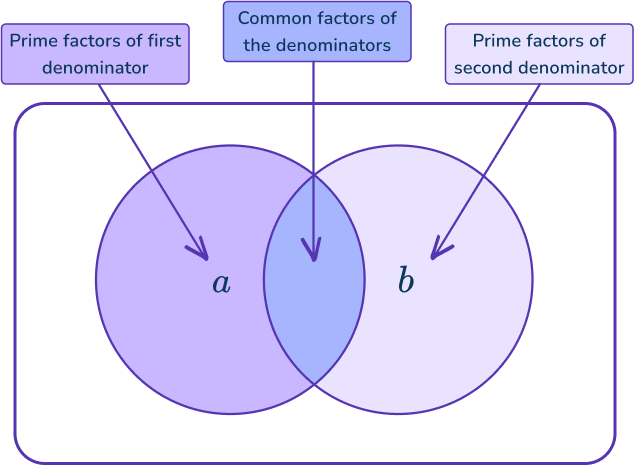
The least common multiple or the least common denominator is ab, you multiply each of the factors in each of the parts together, so, a \times b=a b.
Rewrite the expressions with the common denominator.
Multiply the first rational (first fractions) expression by \cfrac{b}{b} and the second rational expression by \cfrac{a}{a} .
\begin{aligned}& \cfrac{2}{a} \times \cfrac{b}{b}+\cfrac{3}{b} \times \cfrac{a}{a} \\\\
& \cfrac{2 b}{a b}+\cfrac{3 a}{a b} \end{aligned}
Add or subtract the expressions.
Only add the numerators together.
\cfrac{2 b}{a b}+\cfrac{3 a}{a b}=\cfrac{2 b+3 a}{a b}
If possible, simplify the answer.
The sum cannot be simplified, so the rational expression in simplest form is: \cfrac{2 b+3 a}{a b}.
Example 3: subtracting fractions with unlike denominators
Subtract the expression and write the answer in simplest form.
\cfrac{6}{e}-\cfrac{5}{f}Find the common denominator.
In this case, the common denominator is ef. You can use the Venn diagram strategy or another strategy that you are comfortable with to find the common denominator.
The denominators are already in prime factor form.
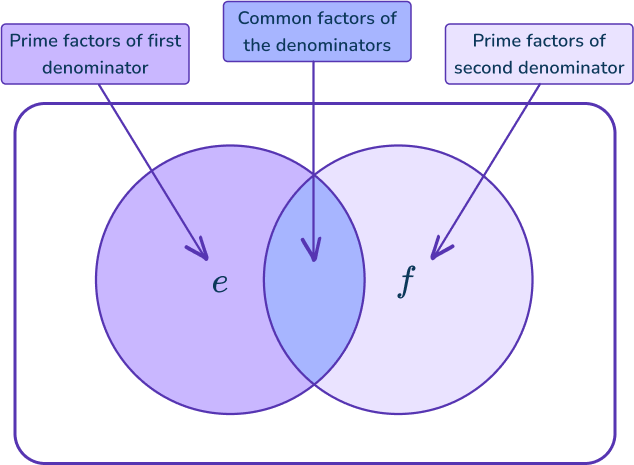
The least common multiple or the least common denominator is ef, you multiply each of the factors in each of the parts together, so, e \times f=e f.
Rewrite the expressions with the common denominator.
Multiply the first rational (first fractions) expression by \cfrac{f}{f} and the second rational expression by \cfrac{e}{e} .
\begin{aligned}& \cfrac{6}{e} \times \cfrac{f}{f}-\cfrac{5}{f} \times \cfrac{e}{e} \\\\
& \cfrac{6 f}{e f}-\cfrac{5 e}{e f}\end{aligned}
Add or subtract the expressions.
Only subtract the denominators.
\cfrac{6 f}{e f}-\cfrac{5 e}{e f}=\cfrac{6 f-5 e}{e f}
If possible, simplify the answer.
The answer, \cfrac{6 f-5 e}{e f}, cannot be simplified, so the rational expression in simplest form is \cfrac{6 f-5 e}{e f}.
Example 4: subtracting fractions with unlike denominators
Subtract the expressions and write the answer in simplest form.
\cfrac{5}{3 x^2}-\cfrac{7}{6 y}Find the common denominator.
Before subtracting the expressions, find the common denominator.
First write the prime factors of the denominators:
\begin{aligned}& 3 x^2=3 \cdot x \cdot x \\\\
& 6 y=2 \cdot 3 \cdot y \end{aligned}
Then use the Venn diagram strategy to find the least common multiple which is the least common denominator.
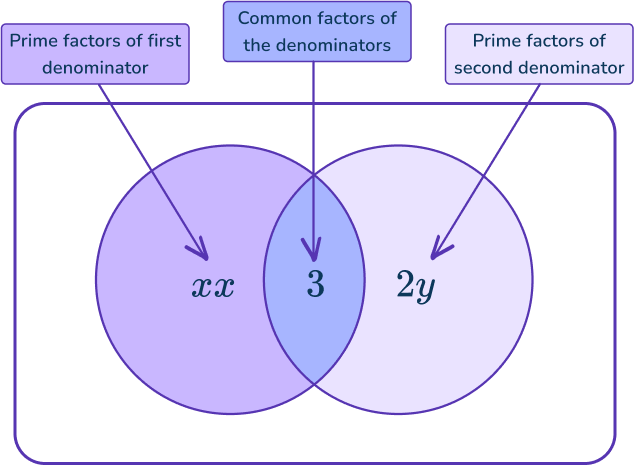
The least common multiple is found by multiplying each of the factors in each of the parts of the Venn diagram together.
x \cdot x \cdot 3 \cdot 2 \cdot y=6 x^2 y
Rewrite the expressions with the common denominator.
In order to rewrite the expressions with the common denominator, multiply the first rational expression by \cfrac{2 y}{2 y} and multiply the second rational expression (second fraction) by \cfrac{x^2}{x^2} .
\begin{aligned}& \cfrac{5}{3 x^2} \times \cfrac{2 y}{2 y}-\cfrac{7}{6 y} \times \cfrac{x^2}{x^2} \\\\
& \cfrac{10 y}{6 x^2 y}-\cfrac{7 x^2}{6 x^2 y} \end{aligned}
Add or subtract the expressions.
Subtract the numerators only.
\cfrac{10 y}{6 x^2 y}-\cfrac{7 x^2}{6 x^2 y}=\cfrac{10 y-7 x^2}{6 x^2 y}
If possible, simplify the answer.
The answer cannot be simplified so the rational expression in simplest form is:
\cfrac{10 y-7 x^2}{6 x^2 y}
Example 5: adding fractions with trinomial denominators
Add the rational expressions and write the answer in simplest form.
\cfrac{4}{x^2-5 x-14}+\cfrac{8}{x-7}Find the common denominator.
You need to find the common denominator before you can add the rational expressions. Since the denominators are not monomials, you have to look to factor them if possible.
In this case, the first denominator of x^2-5 x-14 can be factored into (x-7)(x+2).
\begin{aligned}& \cfrac{4}{x^2-5 x-14}+\cfrac{8}{x-7} \\\\
& \cfrac{4}{(x-7)(x+2)}+\cfrac{8}{x-7} \end{aligned}
Using the Venn diagram strategy to find the least common multiple:
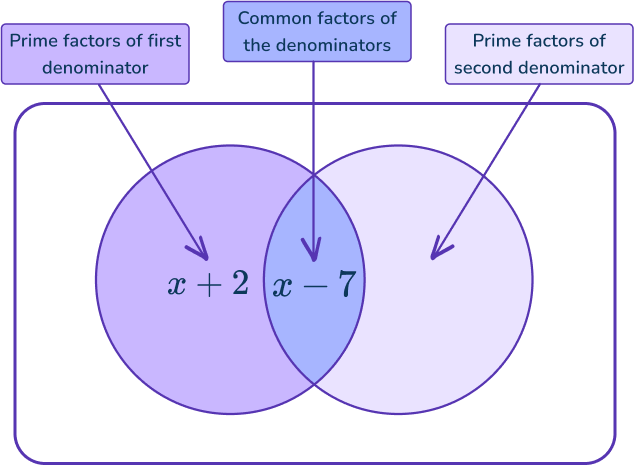
The least common multiple is found by multiplying each of the factors in each of the parts of the Venn diagram together.
(x+2)(x-7) \rightarrow \text { LCM }
Rewrite the expressions with the common denominator.
The first rational expression already has the least common denominator so you do not have to multiply it to anything. Multiply the second rational expression (second fraction) by \cfrac{x+2}{x+2} .
\begin{aligned}&\cfrac{4}{x^2-5 x-14}+\cfrac{8}{x-7} \\\\
&\begin{aligned}& \cfrac{4}{(x-7)(x+2)}+\cfrac{8}{x-7} \times \cfrac{x+2}{x+2} \\\\
& \cfrac{4}{(x-7)(x+2)}+\cfrac{8(x+2)}{(x-7)(x+2)} \\\\
& \cfrac{4}{(x-7)(x+2)}+\cfrac{8 x+16}{(x-7)(x+2)} \end{aligned} \end{aligned}
Add or subtract the expressions.
Add the numerators together by combining like terms.
\begin{aligned}& \cfrac{4}{(x-7)(x+2)}+\cfrac{8 x+16}{(x-7)(x+2)} \\\\
& \cfrac{20+8 x}{(x-7)(x+2)} \end{aligned}
If possible, simplify the answer.
The answer cannot be simplified so the answer can be written in factored form as, \cfrac{20+8 x}{(x-7)(x+2)}, or you can multiply the denominator \cfrac{20+8 x}{x^2-5 x-14}.
Example 6: subtracting fractions with different denominators
Subtract the expressions and write the answer in simplest form.
\cfrac{2}{x^2-1}-\cfrac{4}{x^2+4 x+3}Find the common denominator.
You need to find the common denominator before you can subtract the rational expressions. Since the denominators are not monomials, you have to look to factor them if possible.
In this case, the both denominators of x^2-1 and x^2+4 x+3 need to be factored.
The first denominator factors to be: x^2-1=(x+1)(x-1)
The second denominator factors to be: x^2+4 x+3=(x+1)(x+3)
Using the Venn diagram strategy to find the least common multiple:
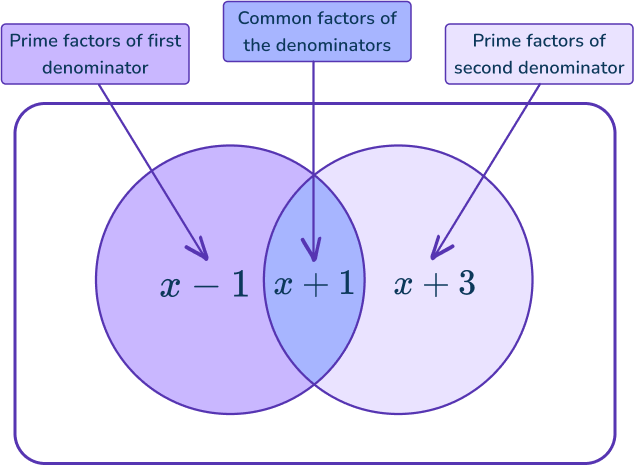
The least common multiple is found by multiplying each of the factors in each of the parts of the Venn diagram together, (x-1)(x+1)(x+3).
Rewrite the expressions with the common denominator.
Multiply the first rational expression by \cfrac{x+3}{x+3} and multiply the second rational expression (second fraction) by \cfrac{x-1}{x-1}.
\begin{aligned}& \cfrac{2}{x^2-1}-\cfrac{4}{x^2+4 x+3} \\\\
& \cfrac{2}{(x-1)(x+1)}-\cfrac{4}{(x+1)(x+3)} \\\\
& \cfrac{2}{(x-1)(x+1)} \times \cfrac{x+3}{x+3}-\cfrac{4}{(x+1)(x+3)} \times \cfrac{x-1}{x-1} \\\\
& \cfrac{2(x+3)}{(x-1)(x+1)(x+3)}-\cfrac{4(x-1)}{(x+1)(x+3)(x-1)} \\\\
& \cfrac{2 x+6}{(x-1)(x+1)(x+3)}-\cfrac{4 x-4}{(x+1)(x+3)(x-1)} \end{aligned}
Add or subtract the expressions.
Add the numerators together by combining like terms.
\begin{aligned}& \cfrac{2 x+6}{(x-1)(x+1)(x+3)}-\cfrac{4 x-4}{(x+1)(x+3)(x-1)} \\\\ & \cfrac{2 x+6-4 x+4}{(x-1)(x+1)(x+3)} \\\\ & \cfrac{- \, 2 x+10}{(x-1)(x+1)(x+3)} \end{aligned}
If possible, simplify the answer.
The answer cannot be simplified so the answer can be written in factored form as \cfrac{- \, 2 x+10}{(x-1)(x+1)(x+3)} or you can multiply the denominator \cfrac{- \, 2 x+10}{x^3+3x^{2}-x-3}.
Teaching tips for adding and subtracting rational expressions
- Make connections between operations with fractions to operations with rational functions so that students can develop understanding.
- Use active learning activities such as scavenger hunts or game playing to have students review skills instead of giving them a worksheet.
- Encourage students who are struggling to use digital platforms such as Khan Academy so they can view tutorial videos.
Easy mistakes to make
- Not distributing the negative when subtracting rational expressions
For example, when subtracting, \cfrac{2 x}{7}-\cfrac{x-1}{7},
Writing the answer as \cfrac{x-1}{7} which is not correct.
Instead, the negative has to be distributed to both the x and the - \, 1, so the actual answer is \cfrac{x+1}{7} .
- Writing the equivalent rational expression with common denominator incorrectly
For example, when adding \cfrac{5}{(x-4)}+\cfrac{8}{(x+2)}, the common denominator is (x-4)(x+2).
When writing the equivalent expressions, only multiplying the denominator by the missing factor is incorrect, \cfrac{5}{(x-4)(x+2)}+\cfrac{8}{(x+2)(x-4)}≠ \cfrac{13}{(x+2)(x-4)}
When writing the new expressions with the common denominator, the numerator and denominator must be multiplied by the missing factor(s).
\begin{aligned}& \cfrac{5}{(x-4)} \times \cfrac{x+2}{x+2}+\cfrac{8}{(x+2)} \times \cfrac{x-4}{x-4} \\\\ & \cfrac{5(x+2)}{(x-4)(x+2)}+\cfrac{8(x-4)}{(x+2)(x-4)} \\\\ & \cfrac{5 x+10}{(x-4)(x+2)}+\cfrac{8 x-32}{(x+2)(x-4)} \\\\ & \cfrac{13 x-22}{(x-4)(x+2)} \end{aligned}
Related rational function lessons
Practice adding and subtracting rational expressions questions
1. Add the rational expressions and write the answer in simplest form.
\cfrac{1}{c}+\cfrac{4}{d}




In order to add the rational expressions together, you must first find the common denominator.
The common denominator in this case is cd, which means the first rational expression has to be multiplied by \cfrac{d}{d} and the second rational expression has to be multiplied by \cfrac{c}{c}.
\begin{aligned}&\cfrac{1}{c}+\cfrac{4}{d} \\\\ &=\cfrac{1\times{d}}{c\times{d}}+\cfrac{4\times{c}}{d\times{c}} \\\\ &=\cfrac{d}{cd}+\cfrac{4c}{cd} \\\\ &=\cfrac{d+4c}{cd} \\\\ &=\cfrac{4c+d}{cd} \end{aligned}
The expression cannot be simplified further, so the final answer is
\cfrac{4 c+d}{c d}.
2. Subtract the rational expressions and write the answer in simplest form.
\cfrac{9}{g}-\cfrac{7}{h}




In order to subtract the rational expressions, you must first find the common denominator. In this case the common denominator is gh.
Multiply the first rational expression by \cfrac{h}{h} and multiply the second rational expression by \cfrac{g}{g}.
\begin{aligned}&\cfrac{9}{g}-\cfrac{7}{h} \\\\ &=\cfrac{9\times{h}}{g\times{h}}-\cfrac{7\times{g}}{h\times{g}} \\\\ &=\cfrac{9h}{gh}-\cfrac{7g}{gh} \\\\ &=\cfrac{9h-7g}{gh} \end{aligned}
The answer cannot be simplified further, so the final answer is
\cfrac{9 h-7 g}{g h}.
3. Add the rational expressions and write the answer in simplest form.
\cfrac{1}{2x}+\cfrac{4}{x+2}




In order to multiply the expressions together, you need to find the common denominator. The common denominator is (2 x)(x+2).
Multiply the first rational expression by \cfrac{x+2}{x+2} and multiply the second rational expression by \cfrac{2 x}{2 x}.
\begin{aligned}&\cfrac{1}{2x}+\cfrac{4}{x+2} \\\\ &=\cfrac{1\times{(x+2)}}{2x\times{(x+2)}}+\cfrac{4\times{2x}}{(x+2)\times{2x}} \\\\ &=\cfrac{x+2}{2x(x+2)}+\cfrac{8x}{2x(x+2)} \\\\ &=\cfrac{x+2+8x}{2x(x+2)} \\\\ &=\cfrac{9x+2}{2x(x+2)} \end{aligned}
The answer cannot be simplified further, so the final answer is
\cfrac{9x+2}{2x(x+2)}.
4. Subtract the rational expressions and write the answer in simplest form.
\cfrac{10}{x-3}-\cfrac{4}{x-1}




Find the common denominator before subtracting the rational expressions. The common denominator is (x-3)(x-1).
Multiply the first rational expression by \cfrac{x-1}{x-1} and multiply the second rational expression by \cfrac{x-3}{x-3}.
\begin{aligned}&\cfrac{10}{x-3}-\cfrac{4}{x-1} \\\\ &=\cfrac{10\times{(x-1)}}{(x-3)\times{(x-1)}}-\cfrac{4\times{(x-3)}}{(x-1)\times{(x-3)}} \\\\ &=\cfrac{10x-10}{(x-3)(x-1)}-\cfrac{4x-12}{(x-3)(x-1)} \\\\ &=\cfrac{10x-10-(4x-12)}{(x-3)(x-1)} \\\\ &=\cfrac{10x-10-4x+12}{(x-3)(x-1)} \\\\ &=\cfrac{6x+2}{(x-3)(x-1)} \\\\ &=\cfrac{2(3x+1)}{(x-3)(x-1)} \end{aligned}
The answer cannot be simplified further, so the final answer is
\cfrac{2(3 x+1)}{(x-3)(x-1)}.
5. Subtract the rational expressions and write the answer in simplest form.
\cfrac{x-1}{x+2}-\cfrac{x-1}{x^{2}-4}




Before subtracting the rational expressions, first find the common denominator. However, in order to find the common denominator, you must first factor the denominators.
In this case, the first denominator cannot be factored, but the second denominator, x^2-4 can be factored using the strategy of factoring the difference of squares.
x^2-4=(x+2)(x-2)
The expression can be written as:
\begin{aligned}& \cfrac{x-1}{x+2}-\cfrac{x-1}{x^2-4} \\\\ & \cfrac{x-1}{x+2}-\cfrac{x-1}{(x+2)(x-2)} \end{aligned}
The common denominator in this case is (x+2)(x-2). Multiply the first rational expression by \cfrac{x-2}{x-2}, the second rational expression already has the common denominator so no need to multiply it by anything.
\begin{aligned}&\cfrac{x-1}{x+2}-\cfrac{x-1}{x^{2}-4} \\\\ &=\cfrac{(x-1)\times{(x-2)}}{(x+2)\times{(x-2)}}-\cfrac{x-1}{(x+2)(x-2)} \\\\ &=\cfrac{(x-1)(x-2)}{(x+2)(x-2)}-\cfrac{x-1}{(x+2)(x-2)} \\\\ &=\cfrac{x^{2}-3x+2}{(x+2)(x-2)}-\cfrac{x-1}{(x+2)(x-2)} \\\\ &=\cfrac{x^{2}-3x+2-(x-1)}{(x+2)(x-2)} \\\\ &=\cfrac{x^{2}-3x+2-x+1}{(x+2)(x-2)} \\\\ &=\cfrac{x^{2}-4x+3}{(x+2)(x-2)} \\\\ &=\cfrac{(x-3)(x-1)}{(x+2)(x-2)} \end{aligned}
6. Add the rational expressions and write the answer in simplest form.
\cfrac{x+5}{x^{2}-1}+\cfrac{3x-2}{x+1}




In order to add the rational expressions, you need to find the common denominator. However, before you find the common denominator factor the denominators.
In this case the first denominator needs to be factored using the strategy of factoring the difference of squares.
x^2-1=(x+1)(x-1)
The common denominator is (x+1)(x-1), multiply the second denominator by \cfrac{x-1}{x-1}. The first denominator already has the common denominator so no need to multiply it to anything.
\begin{aligned}& \begin{aligned}& \cfrac{x+5}{x^2-1}+\cfrac{3 x-2}{x+1} \\\\ & \cfrac{x+5}{(x-1)(x+1)}+\cfrac{3 x-2}{x+1} \\\\ & \cfrac{x+5}{(x-1)(x+1)}+\cfrac{3 x-2}{x+1} \times \cfrac{x-1}{x-1} \\\\ & \cfrac{x+5}{(x-1)(x+1)}+\cfrac{(3 x-2)(x-1)}{(x+1)(x-1)}\end{aligned} \\\\ & \begin{aligned}& \cfrac{x+5}{(x-1)(x+1)}+\cfrac{\left(3 x^2-2 x-3 x+1\right)}{(x+1)(x-1)} \\\\ & \cfrac{x+5}{(x-1)(x+1)}+\cfrac{\left(3 x^2-5 x+1\right)}{(x+1)(x-1)} \\\\ & \cfrac{3 x^2-4 x+6}{(x-1)(x+1)} \end{aligned} \end{aligned}
The answer cannot be simplified, so the final answer is
\cfrac{3 x^2-4 x+6}{(x-1)(x+1)}.
Adding and subtracting rational expressions FAQs
In order to solve rational equations, you need to find the common denominator and multiply the entire equation by the common denominator. This clears the equation of fractions. It’s a similar strategy to when you solve equations with numerical fractions.
Typically, you would multiply the equation by the common denominator to clear the equation of fractions to make it easier to solve.
A complex fraction is when there is a fraction in the numerator of a fraction, in the denominator of a fraction or both. Dividing fractions can be written as a complex fraction.
For example, \cfrac{\cfrac{1}{2}}{\cfrac{3}{4}}=\cfrac{1}{2} \div \cfrac{3}{4}
Yes, you learn how to solve rational inequalities in algebra II and precalculus.
Still stuck?
At Third Space Learning, we specialize in helping teachers and school leaders to provide personalized math support for more of their students through high-quality, online one-on-one math tutoring delivered by subject experts.
Each week, our tutors support thousands of students who are at risk of not meeting their grade-level expectations, and help accelerate their progress and boost their confidence.

Find out how we can help your students achieve success with our math tutoring programs.
[FREE] Common Core Practice Tests (3rd to 8th Grade)
Prepare for math tests in your state with these 3rd Grade to 8th Grade practice assessments for Common Core and state equivalents.
Get your 6 multiple choice practice tests with detailed answers to support test prep, created by US math teachers for US math teachers!